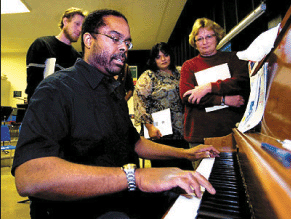by Charley Wyser
From a previous post, we learned to form our 4 basic chords - the Major, minor, Augmented and diminished in the key of C.
1)To form a C Major chord (C chord) we play the notes
1 - 3 - 5 (C E G).
2)To play a C minor chord, we play
1 - b3 - 5 (C Eb G)
3)To play a C Augmented chord, we play
1 - 3 - #5 (C E G#)
4)To play a C diminished chord, we play
1 - b3 - b5
For the more advanced chords, I will give you a chart. If you wish,
print out the chart and keep it near you piano or keyboard for
reference.
I am going to introduce a new term to you - "Intervals".
The intervals mean the note numbers in the scale.
Again, we will apply these numbers to the key of C.
Chord -> Interval -> Key of C example
C Major 7 -> 1 - 3 - 5 - 7 -> C - E - G - B
C Dominant 7 -> 1 - 3 - 5 - b7 -> C - E - G - Bb
C Minor 7 -> 1 - b3 - 5 - b7 -> C - Eb - G - Bb
C Minor 7b5 -> 1 - b3 - b5 - b7 -> C - Eb - Gb - Bb
C Diminished 7 -> 1 - b3 - b5 -bb7 -> C - Eb - Gbb -Bbb(A)
You will notice on the Diminished 7 chord there is a Bbb.
This is called a double-flat. This is actually the same as the 6 in
the C scale.
So another way of thinking of the Diminished 7 chord is to play
1 - b3 - b5 - 6
But you would not teach it this way, because technically this is
incorrectly stated.
One interesting thing to note is that each of these four note chords is based on one of
the four basic chords.
The Major 7th and Dominant 7th chords are both based on the Major chord. If you look
closely at the intervals, you will notice that both of these chords contain the
numbers 1 - 3 - 5 (Major chord).
Similarly, you will notice that the Minor 7th chord contains 1 - b3 - 5 (minor chord).
Lastly, both the Minor 7b5 (also called a Half-Diminished 7th), and the Diminished 7th are
both formed from the diminished chord because they contain 1 - b3 - b5.
The top note (7th tone) is going to be what differentiates the more advanced four-note chords
from their basic root chords (Major, minor, Augmented, diminished).
If you are interested in finding out more about chords and how they move, be sure to look at
my program, The Secret 7 Numbers of Successful Piano Playing.
As they say, "A Picture Is Worth A Thousand Words".
Until then, Keep Having Fun!
Charley Wyser
easypiano.com
To view my Free online lessons, click here
To listen to podcasts, click here






No comments:
Post a Comment